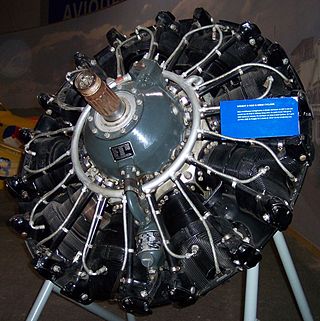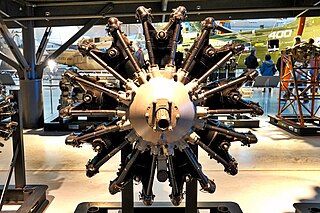
The radial engine is a reciprocating type internal combustion engine configuration in which the cylinders "radiate" outward from a central crankcase like the spokes of a wheel. It resembles a stylized star when viewed from the front, and is called a "star engine" in some other languages.

Wright Aeronautical (1919–1929) was an American aircraft manufacturer headquartered in Paterson, New Jersey. It was the successor corporation to Wright-Martin. It built aircraft and was a supplier of aircraft engines to other builders in the golden age of aviation. Wright engines were used by Amelia Earhart and Charles Lindbergh. In 1929, the company merged with Curtiss Aeroplane and Motor Corporation to form Curtiss-Wright.

The Wright R-1820 Cyclone 9 is an American radial engine developed by Curtiss-Wright, widely used on aircraft in the 1930s through 1950s. It was produced under license in France as the Hispano-Suiza 9V or Hispano-Wright 9V, and in the Soviet Union as the Shvetsov M-25.

Wright Cyclone was the name given to a family of air-cooled radial piston engines designed by the Wright Aeronautical Corporation and used in numerous American aircraft in the 1930s, 1940s and 1950s.

The Pratt & Whitney R-1340 Wasp is an aircraft engine of the reciprocating type that was widely used in American aircraft from the 1920s onward. It was the Pratt & Whitney aircraft company's first engine, and the first of the famed Wasp series. It was a single-row, nine-cylinder, air-cooled, radial design, and displaced 1,344 cubic inches (22 L); bore and stroke were both 5.75 in (146 mm). A total of 34,966 engines were produced.

The XP-13 Viper was a prototype biplane fighter aircraft designed by the American company Thomas-Morse Aircraft Corporation. The airplane was delivered to the United States Army in 1929, but they did not adopt it.

The Wright R-975 Whirlwind was a series of nine-cylinder air-cooled radial aircraft engines built by the Wright Aeronautical division of Curtiss-Wright. These engines had a displacement of about 975 cu in (15.98 L) and power ratings of 300–450 hp (220–340 kW). They were the largest members of the Wright Whirlwind engine family to be produced commercially, and they were also the most numerous.

The Curtiss R-600 Challenger was a six-cylinder, double-row, air-cooled, radial engine for aircraft use built in the United States in the late 1920s. It developed 170 to 180 horsepower.

The Lawrance J-1 was an engine developed by Charles Lanier Lawrance and used in American aircraft in the early 1920s. It was a nine-cylinder, air-cooled radial design.

The Consolidated Model 2 was a training airplane used by the United States Army Air Corps, under the designation PT-3 and the United States Navy under the designation NY-1.

The Wright R-760 Whirlwind was a series of seven-cylinder air-cooled radial aircraft engines built by the Wright Aeronautical division of Curtiss-Wright. These engines had a displacement of 756 in³ (12.4 L) and power ratings of 225-350 hp (168-261 kW).

The Curtiss Model 55 Kingbird was an airliner built in small numbers in the United States in the early 1930s. It was a twin-engine aircraft with a fuselage derived from the single-engine Curtiss Thrush. The Kingbird had two engine nacelles mounted on the struts on either side of the fuselage that braced the wing and the outrigger undercarriage. A distinctive design feature was the aircraft's blunt nose, located behind the propeller arcs. This allowed the engines to be mounted closer to each other and to the aircraft's centerline, therefore minimising asymmetrical thrust in case of an engine failure. For the same reason, the Thrush's single tailfin was replaced by twin tails on the Kingbird, and the main production model, the D-2 fitted a second horizontal stabilizer and elevator between these fins.

The International F-17 Sportsman was a 1920s American three-seat open-cockpit biplane designed and manufactured by the International Aircraft Corporation in Long Beach, California and Cincinnati, Ohio. 107 aircraft were built, 77 of them at Cincinnati.

The Wright R-790 Whirlwind was a series of nine-cylinder air-cooled radial aircraft engines built by Wright Aeronautical Corporation, with a total displacement of about 790 cubic inches (12.9 L) and around 200 horsepower (150 kW). These engines were the earliest members of the Wright Whirlwind engine family.

The Wright R-540 Whirlwind was a series of five-cylinder air-cooled radial aircraft engines built by the Wright Aeronautical division of Curtiss-Wright. These engines had a displacement of 540 in³ (8.85 L) and power ratings of around 165-175 hp (123-130 kW). They were the smallest members of the Wright Whirlwind engine family.

The Lycoming R-680 is a nine-cylinder air-cooled radial engine, the first aero engine produced by Lycoming. The engine was produced in two types, the E and B series; both are essentially the same. The B4E was available in a trainer version with a front exhaust collector "ring" for use without cylinder air baffles. R-680 received Approved Type Certificate No. 42 on 4 Feb 1930.
Lawrance Aero Engine Company was an American aircraft engine manufacturer. Founded by engine pioneer Charles Lawrance, it designed one of the first successful air-cooled radial engines. It existed for only 5 years, being acquired by Wright Aeronautical, a much larger company better able to mass-produce Lawrance's radial engines.
The Nakajima Ha5 is a twin row, 14 cylinder air-cooled radial aircraft engine built by the Japanese Nakajima Aircraft Company. The engine was a development of earlier single-row Japanese engines, the Kotobuki and Hikari, which had combined features of the Bristol Jupiter and Pratt & Whitney R-1340 Wasp designs.

The I.Ae. 16 "El Gaucho" is a nine-cylinder air-cooled radial aircraft engine, with a power of about 450 hp (336 kW). It was designed by the Aeronautic Institute of the Argentine Republic in 1943.

















